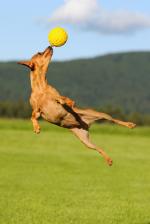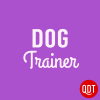Is Your Dog Bored With Her Toys?
The Dog Trainer explains why your dog may be bored with her toys. Plus, how to teach your dog independent play.

Q. My dog doesn’t play with toys by herself. She will reluctantly play with us — tug of war with a rope, stuffed squirrel, and squeaky bone. We have bought her several balls, some that even hide food. When we are not playing with her, she will only lie there sadly staring back at us. I would love it if we could get her to go play by herself when we are busy. Is this possible?
Answer. Maybe, maybe not. A recent study published in Animal Cognition bears out something dog lovers have always thought we knew: Dogs like soft toys that they can tear apart, toys that make noise (did you know that you can buy replacement squeakers, by the way?), and toys that taste like food.
Most dogs will get interested in a new toy – briefly. After a few minutes of chewing or nosing, Dogalini will go on to something else, much like you seeking out new cat videos on YouTube. And – drumroll! – if your dog has lost interest in a toy, you may be able to perk things up by playing with her. But that may not make up for the toy’s loss of novelty value if it’s been hanging around for a while.

This probably has nothing to do with her intelligence but with how persistent she has or hasn’t learned to be. Some food-dispensing toys can be set at varying levels of difficulty: You can change the size of the openings or the size of the food, or you can freeze the food to make extraction a long process. Fiddle with your dog’s toys to make them easier, and see if that helps.
P.S. The researchers in the toy study were John Bradshaw and Anne Pullen, of the University of Bristol in England, and R. J. Merrill of the Waltham Centre for Pet Nutrition. John Bradshaw’s book Dog Sense is a smart, touching, reality-based must-read for anyone who wants to learn more about what’s going on inside your dog.
Pinscher photo courtesy of Shutterstock.


